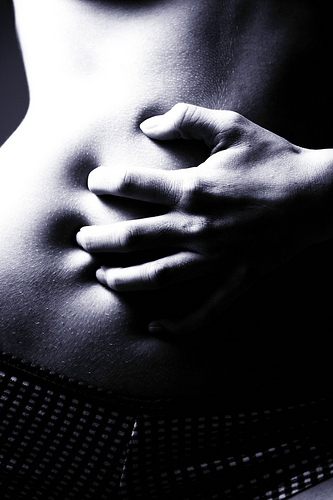 It’s great that menstrual taboo and stigma is ‘over’, as Amanda Fortini informed us earlier this week (see Chris’ post about the menstrual activism shitstorm across several blogs this week). Now maybe all those women suffering from debilitating endometriosis can get some relief.
It’s great that menstrual taboo and stigma is ‘over’, as Amanda Fortini informed us earlier this week (see Chris’ post about the menstrual activism shitstorm across several blogs this week). Now maybe all those women suffering from debilitating endometriosis can get some relief.
Kate Seear’s newly published study about the diagnostic delay in treating endometriosis finds that menstrual etiquette rules and the culture of concealment are among the most profound causes of the delay between the first experience of menstrual pain and the diagnosis of endometriosis, which then opens avenues for relief through either surgery or medical treatment. The delay is non-trivial: research estimates an average delay of 8 years in the UK and 11 years in the US. Reasons for the delay include minimizing of menstrual pain by doctors, family members, and others, and women’s inability to distinguish between ‘normal’ menstrual pain and abnormal pain, and, Seear argues, the social sanctioning women experience when they talk about menstruation in general or menstrual pain in particular.
Copyright restrictions prevent me from re-publishing the article that details her findings and analysis, but here is the abstract:
Endometriosis is a chronic gynaecological condition of uncertain aetiology characterised by menstrual irregularities. Several studies have previously identified a lengthy delay experienced by patients between the first onset of symptoms and eventual diagnosis. Various explanations have been advanced for the diagnostic delay, with both doctors and women being implicated. Such explanations include that doctors normalise women’s menstrual pain and that women might delay in seeking medical advice because they have difficulty distinguishing between ‘normal’ and ‘abnormal’ menstruation. It has been suggested that the diagnostic delay could be reduced if women were trained in how to distinguish between ‘normal’ and ‘abnormal’ menstrual cycles. In this paper I argue that whilst these may be factors in the diagnostic delay, women’s reluctance to disclose problems associated with their menstrual cycle may be a more significant and hitherto neglected factor. I argue women are reluctant to disclose menstrual irregularities because menstruation is a ‘discrediting attribute’ (Goffman, 1963) and disclosure renders women vulnerable to stigmatisation. Women actively conceal their menstrual irregularities through practices of the ‘menstrual etiquette’ (Laws, 1990) which involves the strategic concealment of menstrual problems. This argument is supported through an analysis of the experiences of 20 Australian women diagnosed with endometriosis. The ramifications of this analysis for chronic pain conditions more generally and for practical strategies designed to address the endometriosis diagnostic delay are considered.
If you have access to an academic library (or other source for Social Science & Medicine), I highly recommend reading this article.


I’m pretty sure I have endometriosis. I haven’t been officially diagnosed, but my gynecologist prescribed me the pill because my periods were so heavy and painful, and gave me a pamphlet about endo. In addition to the cramps of death, which I had no idea weren’t normal (because I’ve always had them) until I went on the pill, I also get severe pain in my left knee and hip, nausea and lightheadedness, and an ovarian cyst that doesn’t seem to want to go away (despite all my doctors saying “oh, that’s just temporary, leave it alone and it’ll go away,” it’s always there the next time I get an exam or ultrasound).
From what I’ve read, endo can only be definitively diagnosed through surgery, and I don’t really want to go under the knife just for a diagnosis of something they can’t really do much about anyway.
The “menstrual etiquette” thing is a bitch. For years I seemed to be much more affected by cramps than many of my female friends, but I always figured I was just lazy and they were tougher, or something. Now that I’m on the pill, I’m not incapacitated for 2-3 days a month and I can see that the pain I was having was severe. I wish the dialogue around menstruation was more open, and people understood that some women have pain so crippling it can keep them from doing their jobs and living their lives.
This statement from the abstract is critical:
“It has been suggested that the diagnostic delay could be reduced if women were trained in how to distinguish between ‘normal’ and ‘abnormal’ menstrual cycles. In this paper I argue that whilst these may be factors in the diagnostic delay, women’s reluctance to disclose problems associated with their menstrual cycle may be a more significant and hitherto neglected factor.”
Both these factors are equally important and interconnected. Helping girls and women to acquire what I have come to call “body literacy” (knowing how to observe, chart and interpret our menstrual cycle events to inform our gynecological and overall health and wellness) is the best way to help us discern between what’s normal and what’s not. By so doing we blow up the secrecy code around talking about periods, then, asking for and getting help when help is warranted, becomes a matter of course.